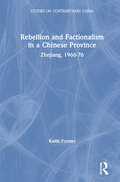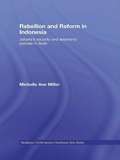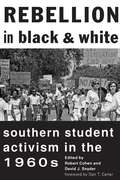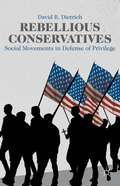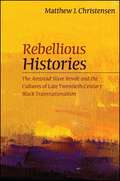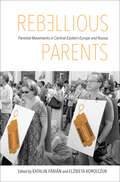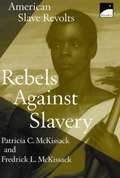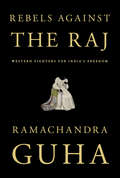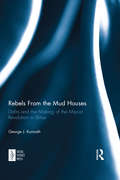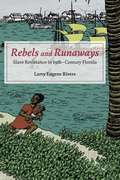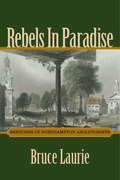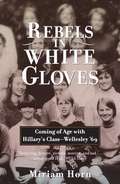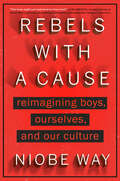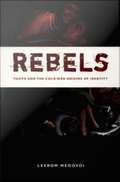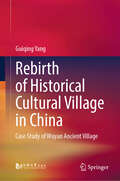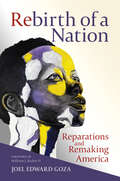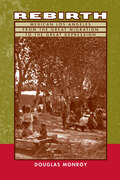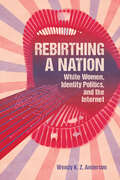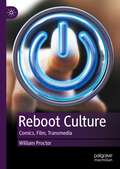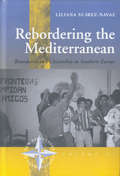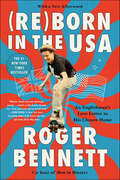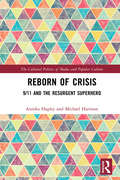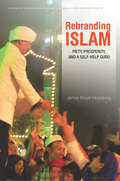- Table View
- List View
Rebellion and Factionalism in a Chinese Province: Zhejiang, 1966-76
by Keith ForsterA detailed case study of provincial politics during the decade-long Cultural Revolution, which analyzes the form and changing nature of mass organizations established in China by 1966. The text traces their evolution, activities and ultimate dissolution ten years later.
Rebellion and Reform in Indonesia: Jakarta's security and autonomy policies in Aceh (Routledge Contemporary Southeast Asia Series)
by Michelle Ann MillerArmed separatist movements in Papua, East Timor and Aceh have been a serious problem for Indonesia's central government. This book examines the policies of successive Indonesian governments to contain secessionist forces, focusing in particular on Jakarta's response towards the armed separatist movement in Aceh. Unlike other studies of separatism in Indonesia, this book concentrates on the responses of the central government rather than looking only at the separatist forces. It shows how successive governments have tried a wide range of approaches including military repression, offers of autonomy, peace talks and a combination of these. It discusses the lessons that have been learned from these different approaches and analyzes the impact of the tsunami, including the successful accommodation of former rebels within an Indonesian devolved state structure and the expanding implementation of Islamic law.
Rebellion in Black and White: Southern Student Activism in the 1960s
by Robert Cohen David J. SnyderThe book offers a panoramic view of southern student activism in the 1960s.Original scholarly essays demonstrate how southern students promoted desegregation, racial equality, free speech etc. and the personal freedoms associated with the counter-culture of the decade.
Rebellious Conservatives
by David R. DietrichConservative social movements such as the Tea Party are having a huge impact on American politics and social life. Unlike social movements of the past, these conservative protesters are not oppressed minorities but tend to be relatively privileged population groups. So why are they protesting? Rebellious Conservatives examines three conservative movements, the anti-abortion/pro-life movement, the anti-illegal immigration movement, and the Tea Party, to determine why conservatives engagein protest, how they justify such action, and how they seek to reshape America. Drawing upon aspects of social movement and race theory, the author shows how perceived threats to the privileges of these conservatives drives their protest, how these movements have attempted to reshape American identities to protect these privileges, and the potential implications of the success of these movements.
Rebellious Histories: The Amistad Slave Revolt and the Cultures of Late Twentieth-Century Black Transnationalism
by Matthew J. ChristensenFrom the early 1970s to the mid-1990s, playwrights, novelists, filmmakers, visual artists, and prison writers from Sierra Leone and the United States brought a new attention to the events of the 1839 Amistad shipboard slave rebellion. As a testament of the human will to freedom, the story of the Amistad mutineers also describes the wide arc of the international circuits of capital, commerce, juridical power, and diplomacy that structured and reproduced the Atlantic slave trade for nearly four centuries. In Rebellious Histories, Matthew J. Christensen argues that for creative artists struggling to comprehend—and survive—pernicious manifestations of globalization like Sierra Leone's civil war, the Amistad rebellion's narrative of exploitative resource extraction, transatlantic migrations, armed rebellion, and American judicial intervention offers both a historical antecedent and allegory for contemporary global capitalism's reconfiguration of culture and subjectivity. At the same time, he shows how the mutineers' example provides a model for imagining utopian forms of transnationalism. With its wide-ranging comparative approach, Rebellious Histories brings a unique perspective to the study of the cultural histories of both slave resistance and globalization.
Rebellious Parents: Parental Movements in Central-Eastern Europe and Russia
by Fábián, Katalin; Bekiesza-Korolczuk, ElbietaParental activism movements are strengthening around the world and often spark tense personal and political debate. With an emphasis on Russia and Central and Eastern Europe, this collection analyzes formal organizations as well as informal networks and online platforms which mobilize parents to advocate for change on a grassroots level. In doing so, the work collected here explores the interactions between the politics, everyday life, and social activism of mothers and fathers. From fathers' rights movements to natural childbirth to vaccination debates, these essays provide new insight into the identities and strategies applied by these movements as they confront local ideals of gender and family with global ideologies.
Rebels Against Slavery: American Slave Revolts
by Patricia C. Mckissack Fredrick L. MckissackFrom one of today's most distinguished author teams comes a meticulously researched, exciting chronicle of the unsung heroes in the war against slavery.
Rebels Against the Raj: Western Fighters for India's Freedom
by Ramachandra GuhaAn extraordinary history of resistance and the fight for Indian independence—the little-known story of seven foreigners to India who joined the movement fighting for freedom from British colonial rule.Rebels Against the Raj tells the story of seven people who chose to struggle for a country other than their own: foreigners to India who across the late 19th to late 20th century arrived to join the freedom movement fighting for independence from British colonial rule. Of the seven, four were British, two American, and one Irish. Four men, three women. Before and after being jailed or deported they did remarkable and pioneering work in a variety of fields: journalism, social reform, education, the emancipation of women, environmentalism.This book tells their stories, each renegade motivated by idealism and genuine sacrifice; each connected to Gandhi, though some as acolytes where others found endless infuriation in his views; each understanding they would likely face prison sentences for their resistance, and likely live and die in India; each one leaving a profound impact on the region in which they worked, their legacies continuing through the institutions they founded and the generations and individuals they inspired. Through these entwined lives, wonderfully told by one of the world&’s finest historians, we reach deep insights into relations between India and the West, and India&’s story as a country searching for its identity and liberty beyond British colonial rule.
Rebels From the Mud Houses: Dalits and the Making of the Maoist Revolution in Bihar
by George J. KunnathThis book examines Dalit mobilization and the transformation of rural power relations in the context of intense agrarian violence involving Maoist guerrillas and upper caste militias backed by state forces in Bihar in the 1980s. The book investigates why thousands of Dalits took up arms and highlights the specificities of Dalit participation in the Maoist Movement and develops an anthropology of the Maoist Revolution in India.
Rebels and Runaways: Slave Resistance in Nineteenth-Century Florida
by Larry Eugene RiversThis gripping study examines slave resistance and protest in antebellum Florida and its local and national impact from 1821 to 1865. Using a variety of sources, Larry Eugene Rivers discusses Florida's unique historical significance as a runaway slave haven dating back to the seventeenth century. In moving detail, Rivers illustrates what life was like for enslaved blacks whose families were pulled asunder as they relocated and how they fought back any way they could to control small parts of their own lives. Identifying slave rebellions such as the Stono, Louisiana, Denmark (Telemaque) Vesey, Gabriel, and the Nat Turner insurrections, Rivers argues persuasively that the size, scope, and intensity of black resistance in the Second Seminole War makes it the largest sustained slave insurrection in American history.
Rebels in Paradise: Sketches of Northampton Abolitionists
by Bruce LaurieLong ago dubbed the “Paradise of America,” Northampton, Massachusetts, is also known as the home of visionaries—from the Reverend Jonathan Edwards, father of the First Great Awakening, to George W. Benson, brother-in-law of William Lloyd Garrison and a founder of the utopian Northampton Association for Education and Industry. During the mid-nineteenth century the town became a center of political abolitionism and a hub in the Underground Railroad. In this book, Bruce Laurie profiles five rebellious figures who launched Northampton’s abolitionist movement—Sylvester Judd Jr., John Payson Williston, David Ruggles, Henry Sherwood Gere, and Erastus Hopkins. Through their individual stories he traces the evolution of the antislavery movement in western Massachusetts and links it to broader developments in economics, civil life, and political affairs. Northampton’s abolitionists were a heterodox group, yet most were intrepid devotees of democracy and racial equality, idealists who enjoyed genuine friendships and political alliances with African Americans. Several even took the bold step of hiring African Americans in their businesses. They avoided the doctrinal rivalries that sometimes troubled the antislavery movement in other places, skillfully steering clear of the xenophobic nativism that infected Massachusetts politics in the mid–1850s and divided the Republican Party at large. Although a prohibitionist faction disrupted the Northampton abolitionist movement for a time, the leaders prevailed on the strength of their personal prestige and political experience, making the seat of Hampshire County what one of them called an abolitionist “stronghold.”
Rebels in White Gloves: Coming of Age with Hillary's Class--Wellesley '69
by Miriam HornWhen the women of the Wellesley class of 1969 entered the ivory tower, they were initiated into a rarefied world. Many were daughters of privilege, many were going for their "MRS." But by the time they graduated four years later, they faced a world turned upside down by the Pill, NOW, student protests, the counterculture, and the Vietnam War.In this social history, Miriam Horn retraces the lives of women caught on a historic cusp. This generation was the first to test-drive modern rules that remain complicated and contentious regarding sexuality, marriage, motherhood, paid work, spirituality, aging, and the difficulties of reconciling public and private life. The result is a story of uncommon subtleties and vibrancy that reflects this generation's fateful choices.From the Trade Paperback edition.
Rebels with a Cause: Reimagining Boys, Ourselves, and Our Culture
by Niobe WayFrom NYU professor of developmental psychology Niobe Way, an in-depth exploration about what boys and young men teach us about themselves, us, and the toxic culture we have created, one in which we value money over people, toys over human connection, and academic achievement over kindness. Based on her longitudinal and mixed-method research over thirty-five years, Rebels with a Cause is a true call to action to change the culture so that we stop the vicious cycle of violence and blame. Dr. Niobe Way has spent her career researching social and emotional development and finds that boys and young men desperately want and need the same thing as everyone else: close friendships. Yet they and we grow up in a stereotyped &“boy&” culture, one that devalues and mocks those relationships, rather than recognizing that they&’re necessary for human survival. In Rebels with a Cause, Way takes her message one step beyond her previous book, Deep Secrets, which was the inspiration for an Oscar-nominated film Close, to reveal how these &“rebels,&” as she calls the boys and young men in her research and in her classrooms, teach us about their and our crisis of connection, evidence of which is visible in our soaring rates of depression, anxiety, loneliness, suicide, and mass violence. They also teach us about the solutions to the crisis, which is to care, to listen with curiosity, and to take individual and collective responsibility for the damage we have done to them, to ourselves, and to the world around us. Way provides us not only with data-driven insight into the roots and consequences of this crisis of connection, but also offers us concrete and empirically tested strategies for creating a culture that better aligns with our human nature and our human needs. Her book reminds us that &“it&’s not the rebels who cause the troubles of the world, it&’s the troubles that cause the rebels.&” The time to listen to and act on what young rebels have been telling us for almost a century is now.
Rebels, Rogues, and Outlaws: A Pictorial History of WarRoom
by Dan FleuetteAs an artist, Dan Fleuette has always identified with the marginal, the rebels, those at the margins of society. Traditionally, these characters have been artists, musicians, filmmakers, and writers. Since the dawn of woke culture, where many of today&’s artists march in lockstep with the dominant, politically correct corporate news and political space, these marginal characters have taken a different look. Today&’s rebels would have been considered quite mainstream just a few years ago. Included in their ranks are the scorned, mocked, ridiculed and canceled—those who risk everything to dare to speak their mind and run counter to mainstream narratives. These are the people captured in Rebels, Rogues, and Outlaws: A Pictorial History of WarRoom. This is not just a portrait book, it is also a WarRoom historical document showcasing the brave souls who are courageous enough to stand up against a ceaseless and powerful battering of politicians, woke social media tyrants, school boards, editorial pages, and polite society in general. This book is Fleuette&’s small attempt to honor these people, who show us, day in and day out, what real courage is.
Rebels: Youth and the Cold War Origins of Identity
by Leerom MedovoiHolden Caulfield, the beat writers, Elvis Presley, Chuck Berry, and James Dean--these and other avatars of youthful rebellion were much more than entertainment. As Leerom Medovoi shows, they were often embraced and hotly debated at the dawn of the Cold War era because they stood for dissent and defiance at a time when the ideological production of the United States as leader of the "free world" required emancipatory figures who could represent America's geopolitical claims. Medovoi argues that the "bad boy" became a guarantor of the country's anti-authoritarian, democratic self-image: a kindred spirit to the freedom-seeking nations of the rapidly decolonizing third world and a counterpoint to the repressive conformity attributed to both the Soviet Union abroad and America's burgeoning suburbs at home. Alongside the young rebel, the contemporary concept of identity emerged in the 1950s. It was in that decade that "identity" was first used to define collective selves in the politicized manner that is recognizable today: in terms such as "national identity" and "racial identity. " Medovoi traces the rapid absorption of identity themes across many facets of postwar American culture, including beat literature, the young adult novel, the Hollywood teen film, early rock 'n' roll, black drama, and "bad girl" narratives. He demonstrates that youth culture especially began to exhibit telltale motifs of teen, racial, sexual, gender, and generational revolt that would burst into political prominence during the ensuing decades, bequeathing to the progressive wing of contemporary American political culture a potent but ambiguous legacy of identity politics.
Rebirth of Historical Cultural Village in China: Case Study of Wuyan Ancient Village
by Guiqing YangThis book combines theory and practice with typical cases study. Pictures and texts are listed in each chapter for easier understanding. It is suitable for undergraduate and graduate students majoring in urban and rural planning, architecture, and landscape architecture in colleges and universities. It is used as a reference material for personnel engaged in rural planning, design, construction and management, and for the training and learning of rural cadres. Meanwhile, it is also used as a reference for general audience who interested in rural planning and construction. This book hopefully promotes the academic exchange and discussion of the rebirth of mountainous historical and cultural villages in eastern China, encouraging the further localized practice and more attention to historical and cultural villages.
Rebirth of a Nation: Reparations and Remaking America
by Joel Edward GozaJoel Edward Goza dismantles the deep-seated myths that perpetuate white supremacy—and makes the case that reparations are necessary to heal America&’s racial wounds and live up to our democratic ideals. Like many well-intentioned white people, Goza once believed that he could support Black America&’s struggle for equality without supporting reparations. Reparations, he thought, were altogether irrelevant to the real work of racial justice. This is a book about why he was wrong. In fact, any effort to heal our nation&’s wounds will fail without reparations. In Rebirth of a Nation, Goza exposes lesser-known aspects of racism in American history and how Black people have consistently been depicted as responsible for their own oppression to justify slavery, Jim Crow, mass incarceration and gross inequality. Goza&’s iconoclastic and incisive account exposes how revered figures like Thomas Jefferson and Abraham Lincoln embedded white supremacy deep into our nation&’s consciousness—and how Ronald Reagan manipulated this ideology so that society cheered as he advanced a set of policies that wounded our nation and intensified Black America&’s suffering. But Rebirth of a Nation is not merely about accountability. It is also about hope. A reparations process is not a utopian dream; Goza offers a practical path toward closing the racial wealth gap. Rebirth of a Nation shows readers how they can join the reparative process, working toward the creation of a more perfect union.
Rebirth: Mexican Los Angeles from the Great Migration to the Great Depression
by Douglas MonroyThis is a sweeping study of the making of Mexican Los Angeles from around 1910 to the 1940s, one of the most dramatic and historically vibrant periods in the history of Los Angeles and its Mexican communities.
Rebirth: Mexican Los Angeles from the Great Migration to the Great Depression
by Douglas MonroyThis sweeping, vibrant narrative chronicles the history of the Mexican community in Los Angeles. Douglas Monroy unravels the dramatic, complex story of Mexican immigration to Los Angeles during the early decades of the twentieth century and shows how Mexican immigrants re-created their lives and their communities. Against the backdrop of this newly created cityscape, Rebirth explores pivotal aspects of Mexican Los Angeles during this time—its history, political economy, popular culture—and depicts the creation of a time and place unique in Californian and American history.Mexican boxers, movie stars, politicians, workers, parents, and children, American popular culture and schools, and historical fervor on both sides of the border all come alive in this literary, jargon-free chronicle. In addition to the colorful unfolding of the social and cultural life of Mexican Los Angeles, Monroy tells a story of first-generation immigrants that provides important points of comparison for understanding other immigrant groups in the United States.Monroy shows how the transmigration of space, culture, and reality from Mexico to Los Angeles became neither wholly American nor Mexican, but México de afuera, "Mexico outside," a place where new concerns and new lives emerged from what was both old and familiar. This extremely accessible work uncovers the human stories of a dynamic immigrant population and shows the emergence of a truly transnational history and culture. Rebirth provides an integral piece of Chicano history, as well as an important element of California urban history, with the rich, synthetic portrait it gives of Mexican Los Angeles.
Rebirthing a Nation: White Women, Identity Politics, and the Internet (Race, Rhetoric, and Media Series)
by Wendy K. AndersonAlthough US history is marred by institutionalized racism and sexism, postracial and postfeminist attitudes drive our polarized politics. Violence against people of color, transgender and gay people, and women soar upon the backdrop of Donald Trump, Tea Party affiliates, alt-right members like Richard Spencer, and right-wing political commentators like Milo Yiannopoulos who defend their racist and sexist commentary through legalistic claims of freedom of speech. While more institutions recognize the volatility of these white men’s speech, few notice or have thoughtfully considered the role of white nationalist, alt-right, and conservative white women’s messages that organizationally preserve white supremacy. In Rebirthing a Nation: White Women, Identity Politics, and the Internet, author Wendy K. Z. Anderson details how white nationalist and alt-right women refine racist rhetoric and web design as a means of protection and simultaneous instantiation of white supremacy, which conservative political actors including Sarah Palin, Donald Trump, Kellyanne Conway, Sarah Huckabee Sanders, and Ivanka Trump have amplified through transnational politics. By validating racial fears and political divisiveness through coded white identity politics, postfeminist and motherhood discourse functions as a colorblind, gilded cage. Rebirthing a Nation reveals how white nationalist women utilize colorblind racism within digital space, exposing how a postfeminist framework becomes fodder for conservative white women’s political speech to preserve institutional white supremacy.
Reboot Culture: Comics, Film, Transmedia
by William ProctorSince the release of Christopher Nolan’s Batman Begins in 2005, there has been a pronounced surge in alternative uses of the computer term ‘reboot,’ a surge that has witnessed the term deployed in new contexts and new signifying practices, involving politics, fashion, sex, nature, sport, business, and media. As a narrative concept, however, reboot terminology remains widely misused, misunderstood, and misinterpreted across popular, journalistic, and academic discourses, being recklessly and relentlessly solicited as a way to describe a broad range of narrative operations and contradictory groupings, including prequels, sequels, adaptations, revivals, re-launches, generic ‘refreshes,’ and enactments of retroactive continuity. Adopting an inter-disciplinary approach that fuses cultural studies, media archaeology, and discursive approaches, this book challenges existing scholarship on the topic by providing new frameworks and taxonomies that illustrate key differences between reboots and other ‘strategies of regeneration,’ helping to spotlight the various ways in which the culture industries mine their intellectual properties in distinct and novel ways to present them anew. Reboot Culture: Comics, Film, Transmedia is the first academic study to critically explore and interrogate the reboot phenomenon as it emerged historically to describe superhero comics that sought to jettison existing narrative continuity in order to ‘begin again’ from scratch.of franchising in the twenty-first century. of franchising in the twenty-first century.
Rebordering The Mediterranean
by Liliana Suajrez-NavazOffering a rich ethnographic account, this book traces the historical processes by which Andalusians experienced the shift from being poor emigrants to northern Europe to becoming privileged citizens of the southern borderland of the European Union, a region where thousands of African immigrants have come in search of a better life. It draws on extended ethnographic fieldwork in Granada and Senegal, exploring the shifting, complementary and yet antagonistic relations between Spaniards and African immigrants in the Andalusian agrarian work place. The author's findings challenge the assumption of fixed national, cultural, and socioeconomic boundaries vis-à-vis outside migration in core countries, showing how legal and cultural identities of Andalusians are constructed together with that of immigrants.
Reborn in the USA: An Englishman's Love Letter to His Chosen Home
by Roger BennettThe #1 New York Times BestsellerOne-half of the celebrated Men in Blazers duo, longtime culture and soccer commentator Roger Bennett traces the origins of his love affair with America, and how he went from a depraved, pimply faced Jewish boy in 1980’s Liverpool to become the quintessential Englishman in New York. A memoir for fans of Jon Ronson and Chuck Klosterman, but with Roger Bennett’s signature pop culture flair and humor.Being a teenager isn’t easy, no matter where in the world you live or how much it does or doesn’t rain in your hometown. As an outsider—a private-schooled Jewish kid in working-class, heavily Catholic Liverpool—Roger Bennett wasn’t winning any popularity contests. But there was one idea, or ideal, that burned bright in Roger’s heart. That was America— with its sunny skies, beautiful women, and cool kids with flipped collars who ate at McDonald’s. When he embraced American popular culture, the dull gray world he lived in turned to neon teal—a color which had not even been invented in England yet. Introduced first through the gateway drug of The Love Boat, then to Rolling Stone, the NFL, John Hughes movies, Run-DMC, and Tracy Chapman, Roger embraced everything that would capture the imagination of a teenager growing up Stateside. When he made a real, in-the-flesh American friend who invited him over for the summer, he got to visit the promised land. A month in Chicago, and a life-changing night spent in the company of the Chicago Bears, was the first hit of freedom, of independence, of the Roger Bennett he knew he could be.(Re)Born in the USA captures the universality of growing pains, growing up, and growing out of where you come from. Drenched in the culture of the late ’80s and ’90s from the UK and the USA, and the heartfelt, hilarious sense of humor that has made Roger Bennett so beloved by his listeners, here is both a truly unique coming-of-age story and the love letter to America that the country needs right now.
Reborn of Crisis: 9/11 and the Resurgent Superhero (The Cultural Politics of Media and Popular Culture)
by Michael Harrison Annika HagleyThis book examines the dominant popular culture convention of the superhero, situated within the most significant global event of the last 20 years. Exploring the explosion of the superhero genre post-9/11, it sheds fresh light on the manner in which American society has processed and continues to process the trauma from the terrorist attacks. Beginning with the development of Batman in comics, television, and film, the authors offer studies of popular films including Iron Man, Captain America, The X-Men, Black Panther, and Wonder Woman, revealing the ways in which these texts meditate upon the events and aftermath of 9/11 and challenge the dominant hyper-patriotic narrative that emerged in response to the attacks. A study of the superhero genre’s capacity to unpack complex global interplays that question America’s foreign policy actions and the white, militarized masculinity that has characterized major discourses following 9/11, this volume explores the engagement of superhero films with issues of authority, patriotism, war, morals, race, gender, surveillance, the military industrial complex, and American political and social identities. As such, it will appeal to scholars and students of cultural and media studies, film studies, sociology, politics, and American studies.
Rebranding Islam: Piety, Prosperity, and a Self-Help Guru
by James Bourk HoestereyKyai Haji Abdullah Gymnastiar, known affectionately by Indonesians as "Aa Gym" (elder brother Gym), rose to fame via nationally televised sermons, best-selling books, and corporate training seminars. In Rebranding Islam James B. Hoesterey draws on two years' study of this charismatic leader and his message of Sufi ideas blended with Western pop psychology and management theory to examine new trends in the religious and economic desires of an aspiring middle class, the political predicaments bridging self and state, and the broader themes of religious authority, economic globalization, and the end(s) of political Islam. At Gymnastiar's Islamic school, television studios, and MQ Training complex, Hoesterey observed this charismatic preacher developing a training regimen called Manajemen Qolbu into Indonesia's leading self-help program via nationally televised sermons, best-selling books, and corporate training seminars. Hoesterey's analysis explains how Gymnastiar articulated and mobilized Islamic idioms of ethics and affect as a way to offer self-help solutions for Indonesia's moral, economic, and political problems. Hoesterey then shows how, after Aa Gym's fall, the former celebrity guru was eclipsed by other television preachers in what is the ever-changing mosaic of Islam in Indonesia. Although Rebranding Islam tells the story of one man, it is also an anthropology of Islamic psychology.
